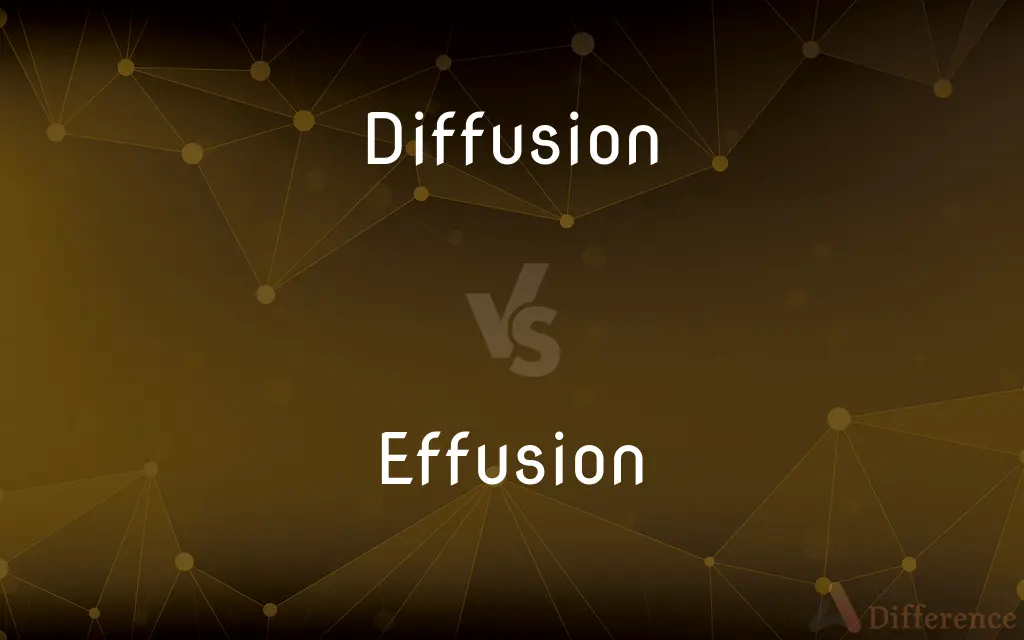Diffusion vs. Effusion — What's the Difference?
By Maham Liaqat & Fiza Rafique — Updated on March 29, 2024
Diffusion involves the spread of particles through random motion from higher to lower concentration, whereas effusion is the process of gas particles passing through a tiny opening.

Difference Between Diffusion and Effusion
Table of Contents
ADVERTISEMENT
Key Differences
Diffusion is a fundamental process in which particles move from an area of higher concentration to an area of lower concentration until equilibrium is achieved. This movement is driven by the random motion of particles and occurs in gases, liquids, and solids. Effusion, on the other hand, specifically involves gas particles escaping through a small hole into a vacuum or lower pressure area. The rate of effusion for a gas is governed by Graham's law, which states that the rate of effusion is inversely proportional to the square root of its molar mass.
While diffusion can be observed in various contexts, such as the spreading of a drop of ink in water or the dispersion of a perfume aroma in air, effusion is a more specialized process that often requires controlled conditions to observe, like in the case of a gas leaking from a balloon through a tiny puncture. Effusion is crucial in processes like gas separation and the study of molecular properties.
Diffusion plays a critical role in biological systems, facilitating essential processes such as the exchange of oxygen and carbon dioxide in the lungs and the movement of nutrients and waste products across cell membranes. Effusion, while less common in everyday observations, is important in scientific research and industrial applications, especially where selective gas transport and separation are required.
The rate of diffusion is influenced by factors such as temperature, the medium in which it occurs, and the size of the particles. Higher temperatures increase the energy of particles, speeding up diffusion. Effusion rates, while also influenced by temperature, primarily depend on the molecular weight of the gas, with lighter gases effusing more rapidly than heavier ones.
Both diffusion and effusion illustrate the kinetic theory of gases, which describes the behavior of particles in terms of motion, energy, and forces. However, their distinct mechanisms and outcomes highlight the diverse ways in which particles interact and move in different environments and under various conditions.
ADVERTISEMENT
Comparison Chart
Definition
Movement of particles from high to low concentration.
Escape of gas through a tiny opening.
Governing Law
No specific law, but described by Fick's laws for different conditions.
Graham's law, relating rate to molar mass.
Occurrence
In gases, liquids, and solids.
Primarily in gases.
Key Factors
Concentration gradient, temperature, particle size.
Hole size, molar mass of the gas, temperature.
Role in Nature
Essential for biological processes, mixing of substances.
Less common, used in scientific and industrial processes.
Practical Example
Perfume aroma filling a room, osmosis in cells.
Gas leaking from a balloon, gas separation techniques.
Compare with Definitions
Diffusion
Influenced by temperature and medium.
Warmth speeds up the diffusion of fragrance in air.
Effusion
Governed by Graham's law, related to gas molar mass.
Hydrogen effuses faster than oxygen due to its lower molar mass.
Diffusion
Movement of particles from an area of higher concentration to lower concentration.
Oxygen diffusing from the lungs into the bloodstream.
Effusion
Involves movement from high pressure to low pressure or vacuum.
Gas escaping into a vacuum chamber through a small orifice.
Diffusion
Driven by the random motion of particles, seeking equilibrium.
Sugar dissolving evenly in tea without stirring.
Effusion
Influenced by the size of the opening and temperature.
Effusion rate increases with a larger hole or higher temperature.
Diffusion
Occurs across various states of matter.
Diffusion of ink in water or gas in air.
Effusion
Process of gas particles escaping through a small opening.
Helium gas effusing out of a pinhole in a balloon.
Diffusion
Essential in biological and chemical processes.
Nutrient and waste exchange in cells.
Effusion
Specific to gases and their properties.
Used in gas separation technologies.
Diffusion
Diffusion is the net movement of anything (for example, atoms, ions, molecules, energy) from a region of higher concentration to a region of lower concentration. Diffusion is driven by a gradient in concentration.
Effusion
In physics and chemistry, effusion is the process in which a gas escapes from a container through a hole of diameter considerably smaller than the mean free path of the molecules. Such a hole is often described as a pinhole and the escape of the gas is due to the pressure difference between the container and the exterior.
Diffusion
The process of diffusing or the condition of being diffused
The diffusion of new technology around the world.
Effusion
The act or an instance of effusing.
Diffusion
The scattering of incident light by reflection from a rough surface.
Effusion
Liquid or other matter poured forth.
Diffusion
The transmission of light through a translucent material.
Effusion
An unrestrained outpouring of feeling, as in speech or writing
"the devout effusions of sacred eloquence" (Edmund Burke).
Diffusion
The spontaneous intermingling of the particles of two or more substances as a result of random thermal motion.
Effusion
The effused fluid.
Diffusion
The spread of linguistic or cultural practices or innovations within a community or from one community to another.
Effusion
A liquid outpouring.
Diffusion
The act of diffusing or dispersing something, or the property of being diffused or dispersed; dispersion.
Effusion
Process of gases passing through a hole or holes considerably smaller than the mean free path of the gas molecules.
Diffusion
(physics) The scattering of light by reflection from a rough surface, or by passage through a translucent medium.
Effusion
An outpouring of speech or emotion.
Diffusion
(physics) The intermingling of the molecules of a fluid due to random thermal agitation.
Gaseous diffusion
Effusion
(medicine) The seeping of fluid into a body cavity; the fluid itself.
Diffusion
The spread of cultural or linguistic practices, or social institutions, in one or more communities.
Effusion
That which is poured out, literally or figuratively.
Wash me with that precious effusion, and I shall be whiter than sow.
The light effusions of a heedless boy.
Diffusion
(marketing) The gradual spread and adoption of goods or services.
Effusion
The escape of a fluid out of its natural vessel, either by rupture of the vessel, or by exudation through its walls. It may pass into the substance of an organ, or issue upon a free surface.
Diffusion
Exchange of airborne media between regions in space in an apparently random motion of a small scale.
Effusion
An unrestrained expression of emotion
Diffusion
The movement of water vapor from regions of high concentration (high water vapor pressure) toward regions of lower concentration.
Effusion
Flow under pressure
Diffusion
The act of diffusing, or the state of being diffused; a spreading; extension; dissemination; circulation; dispersion.
A diffusion of knowledge which has undermined superstition.
Diffusion
(physics) the process of diffusing; the intermingling of molecules in gases and liquids as a result of random thermal agitation
Diffusion
The spread of social institutions (and myths and skills) from one society to another
Diffusion
The property of being diffused or dispersed
Diffusion
The act of dispersing or diffusing something;
The dispersion of the troops
The diffusion of knowledge
Common Curiosities
Why is effusion important in industrial processes?
Effusion is crucial for gas separation techniques and studying gas properties, benefiting various scientific and industrial applications.
How does the molar mass of a gas affect its rate of effusion?
The rate of effusion of a gas is inversely proportional to the square root of its molar mass; lighter gases effuse more quickly.
What distinguishes diffusion from effusion?
Diffusion involves the spread of particles from an area of high concentration to low, while effusion involves gas escaping through a small opening.
Can diffusion occur in solids?
Yes, diffusion can occur in solids, though it happens much more slowly than in liquids and gases.
How does temperature affect diffusion and effusion?
Temperature increases the energy of particles, accelerating both diffusion and effusion processes.
Is effusion a common natural process?
Effusion is less commonly observed in nature compared to diffusion but occurs in specific conditions like gas leaks.
What role does diffusion play in the human body?
Diffusion is vital for transporting oxygen, carbon dioxide, and nutrients across cell membranes.
How do biological systems use diffusion?
Biological systems rely on diffusion for essential functions like respiration, nutrient uptake, and waste removal.
How does a concentration gradient affect diffusion?
A steeper concentration gradient increases the rate of diffusion, as particles move more rapidly from high to low concentration areas.
What is an example of diffusion in daily life?
The scent of coffee spreading throughout a house in the morning.
What practical applications rely on effusion?
Gas separation, vacuum technology, and leakage detection are some applications that utilize effusion.
How does Graham's law relate to effusion?
Graham's law states that the rate of effusion of a gas is inversely related to the square root of its molar mass, explaining why different gases effuse at different rates.
Why is effusion faster for lighter gases?
Lighter gases have higher average speeds at a given temperature, allowing them to pass through openings more quickly.
Can the rate of diffusion be measured?
Yes, the rate of diffusion can be measured, often using experiments that observe the spread of substances over time.
What factors slow down diffusion in solids?
The tight packing of molecules and the lack of free space in solids slow down the diffusion process compared to gases and liquids.
Share Your Discovery

Previous Comparison
Splinter vs. Sliver
Next Comparison
Suit vs. PetitionAuthor Spotlight
Written by
Maham LiaqatCo-written by
Fiza RafiqueFiza Rafique is a skilled content writer at AskDifference.com, where she meticulously refines and enhances written pieces. Drawing from her vast editorial expertise, Fiza ensures clarity, accuracy, and precision in every article. Passionate about language, she continually seeks to elevate the quality of content for readers worldwide.














































